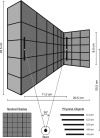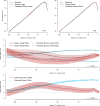Does visuomotor adaptation contribute to illusion-resistant grasping?
- PMID: 28853037
- PMCID: PMC6077986
- DOI: 10.3758/s13423-017-1368-7
Does visuomotor adaptation contribute to illusion-resistant grasping?
Abstract
Do illusory distortions of perceived object size influence how wide the hand is opened during a grasping movement? Many studies on this question have reported illusion-resistant grasping, but this finding has been contradicted by other studies showing that grasping movements and perceptual judgments are equally susceptible. One largely unexplored explanation for these contradictions is that illusion effects on grasping can be reduced with repeated movements. Using a visuomotor adaptation paradigm, we investigated whether an adaptation model could predict the time course of Ponzo illusion effects on grasping. Participants performed a series of trials in which they viewed a thin wooden target, manually reported an estimate of the target's length, then reached to grasp the target. Manual size estimates (MSEs) were clearly biased by the illusion, but maximum grip apertures (MGAs) of grasping movements were consistently accurate. Illusion-resistant MGAs were observed immediately upon presentation of the illusion, so there was no decrement in susceptibility for the adaptation model to explain. To determine whether online corrections based on visual feedback could have produced illusion-resistant MGAs, we performed an exploratory post hoc analysis of movement trajectories. Early portions of the illusion effect profile evolved as if they were biased by the illusion to the same magnitude as the perceptual responses (MSEs), but this bias was attenuated prior to the MGA. Overall, this preregistered study demonstrated that visuomotor adaptation of grasping is not the primary source of illusion resistance in closed-loop grasping.
Keywords: Manual size estimation; Ponzo illusion; Reach-to-grasp; Visuomotor adaptation.
Figures









Similar articles
-
The effect of the Uznadze illusion is temporally dynamic in closed-loop but temporally constant in open-loop grasping.Q J Exp Psychol (Hove). 2024 Jun;77(6):1238-1249. doi: 10.1177/17470218231206907. Epub 2023 Nov 3. Q J Exp Psychol (Hove). 2024. PMID: 37784227
-
Attenuation of size illusion effect in dual-task conditions.Hum Mov Sci. 2019 Oct;67:102497. doi: 10.1016/j.humov.2019.102497. Epub 2019 Jul 18. Hum Mov Sci. 2019. PMID: 31326743
-
Visual illusions modify object size estimates for prospective action judgements.Neuropsychologia. 2018 Aug;117:211-221. doi: 10.1016/j.neuropsychologia.2018.06.003. Epub 2018 Jun 6. Neuropsychologia. 2018. PMID: 29883576
-
Illusions in action: consequences of inconsistent processing of spatial attributes.Exp Brain Res. 2002 Nov;147(2):135-44. doi: 10.1007/s00221-002-1185-7. Epub 2002 Sep 28. Exp Brain Res. 2002. PMID: 12410328 Review.
-
Independent control of the digits predicts an apparent hierarchy of visuomotor channels in grasping.Behav Brain Res. 2002 Nov 15;136(2):427-32. doi: 10.1016/s0166-4328(02)00189-4. Behav Brain Res. 2002. PMID: 12429404 Review.
Cited by
-
Sensorimotor adaptation reveals systematic biases in 3D perception.Sci Rep. 2025 Jan 31;15(1):3847. doi: 10.1038/s41598-025-88214-x. Sci Rep. 2025. PMID: 39885329 Free PMC article.
-
A double dissociation between action and perception in bimanual grasping: evidence from the Ponzo and the Wundt-Jastrow illusions.Sci Rep. 2020 Sep 4;10(1):14665. doi: 10.1038/s41598-020-71734-z. Sci Rep. 2020. PMID: 32887921 Free PMC article.
-
Priming of the Sander Parallelogram illusion separates perception from action.Exp Brain Res. 2021 Jul;239(7):2207-2220. doi: 10.1007/s00221-021-06076-x. Epub 2021 May 19. Exp Brain Res. 2021. PMID: 34013396
-
Perception-Action dissociations depend on factors that affect multisensory processing.PLoS One. 2024 Nov 4;19(11):e0301737. doi: 10.1371/journal.pone.0301737. eCollection 2024. PLoS One. 2024. PMID: 39495722 Free PMC article.
-
Looking at the Ebbinghaus illusion: differences in neurocomputational requirements, not gaze-mediated attention, explain a classic perception-action dissociation.Philos Trans R Soc Lond B Biol Sci. 2023 Jan 30;378(1869):20210459. doi: 10.1098/rstb.2021.0459. Epub 2022 Dec 13. Philos Trans R Soc Lond B Biol Sci. 2023. PMID: 36511402 Free PMC article.
References
-
- Aglioti S, DeSouza JFX, Goodale MA. Size-contrast illusions deceive the eye but not the hand. Current Biology. 1995;5(6):679–685. - PubMed
-
- Bartelt R, Darling WG. Opposite effects on perception and action induced by the Ponzo illusion. Experimental Brain Research. 2002;146(4):433–440. - PubMed
-
- Bingham G, Coats R, Mon-Williams M. Natural prehension in trials without haptic feedback but only when calibration is allowed. Neuropsychologia. 2007;45:288–294. - PubMed
-
- Brenner E, Smeets JBJ. Size illusion influences how we lift but not how we grasp an object. Experimental Brain Research. 1996;11:473–476. - PubMed
MeSH terms
Grants and funding
LinkOut - more resources
Full Text Sources
Other Literature Sources

